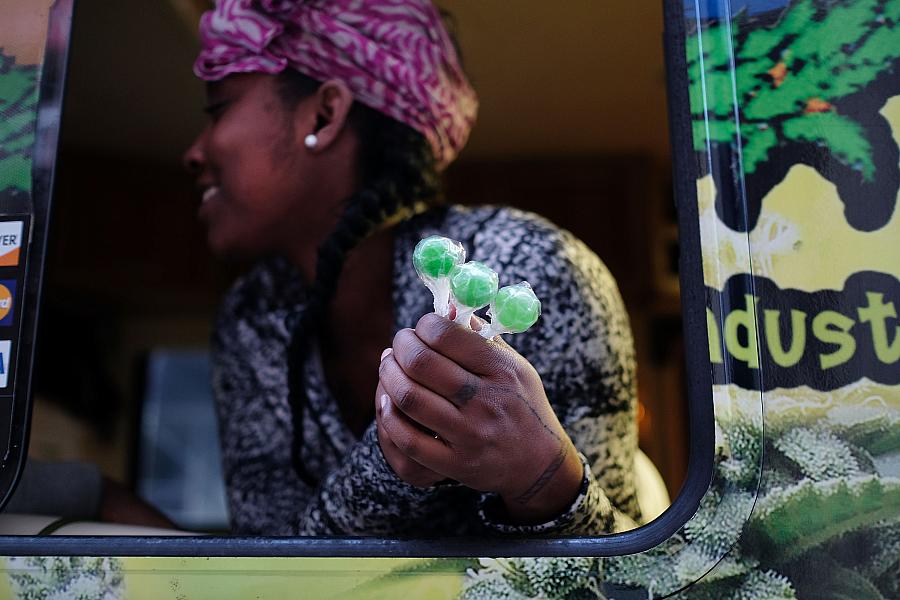When drugs masquerade as sweets, children are often the victims

Photo: Spencer Platt/Getty Images
Reading some of the headlines from recent weeks, you might start wondering if we’re on the cusp of a brave new PSA aimed at parents. A droopy-lidded father sprawls on a couch in the background while a toddler’s searching hands and open mouth seize on the remnants of a pot brownie. Cut to the ER scene and one very anxious mom.
Such an ad seems more plausible in the wake of a recent study from the bellwether state of Colorado that found a marked uptick in children exposed to marijuana since the state legalized recreational use of the drug in 2014. But the problem isn’t just a Rocky Mountain high. Less than two weeks later, news came of a quinceañera in San Francisco’s Mission District at which 13 kids and teens were hospitalized after eating gummies containing marijuana.
The Colorado study and the San Francisco poisoning highlight a disturbing problem: as “edibles” proliferate and the line between drugs and candy blurs, kids are especially vulnerable. And the problem goes beyond old-fashioned parental negligence: faulty packaging, unregulated products and misleading marketing can make it impossible to spot the danger. Those gummy rings in the San Francisco poisoning look indistinguishable from the gas station Peach O’s I use to glut myself on in middle school. You need not be a parent to be worried by this.
One of the most interesting things about the study of Colorado kids is that it tracks how pediatric cases of exposure changed before and after legal recreational pot l hit the market in 2014. The study found that marijuana exposure cases at Children’s Hospital Colorado increased from one case in 2009 to 16 cases in 2015. At a regional poison center, calls increased from nine in 2009 to 47 in 2015, a roughly five-fold increase. For the two-year period before the drug was legalized, there were 1.2 cases per 100,000 kids for marijuana exposure. That rate increased to 2.3 per 100,000 for the two years afterwards.
The state’s rise in pediatric exposures is quite a bit higher than the nation’s as a whole. “Colorado had an average increase in (regional poison center) cases of 34 percent per year, while the remainder of the United States had an increase of 19 percent,” the study notes. At the children’s hospital, the average age was 2 ½. In the more extreme cases, the exposed children became comatose and required breathing tubes.
Edibles were responsible for more than half of the reported cases, according to the researchers. They argue that marijuana-in-disguise poses a growing risk for kids:
Ingestion of edible products continues to be a major source of marijuana exposures in children and poses a unique problem because no other drug is infused into a palatable and appetizing form. These palatable products are often indistinguishable from the non-infused products.
Such edible forms aren’t exactly a niche market either. In Colorado, the popularity of edibles was the “big surprise” the first year recreational sales were legal, as The Denver Post has reported:
The proliferation of marijuana-infused edibles stunned state and industry leaders, making it one of the biggest surprises during the first year of legal recreational marijuana sales. Potent cookies, candies and drinks — once considered a niche market — now account for roughly 45 percent of the legal marijuana marketplace and led to the most high-profile marijuana controversies in 2014.
In a bid to keep marijuana edibles out of little hands, Colorado passed legislation that requires opaque, child-resistant packaging, with ingredients and serving size listed. Washington State took similar steps in 2014 to ban packaging that attracts children.
But such policy moves do little to prevent “user error” or adult negligence, and it’s hard to imagine how packaging would have prevented poisonings at the San Francisco party. “This event is a strong warning about the dangers of edibles, which can be very potent and hard to control dosage in the best circumstances,” said Dr. Thomas Aragon, health officer for San Francisco, in a statement. “A situation like this, where they were consumed by unsuspecting people, and many children, is greatly concerning.”
Edible pot products account for a small fraction of the more than one million exposures reported nationally in 2014 among kids under 6. Beauty products, household cleaners and pharmaceuticals still dwarf munchable marijuana as the source of child poisonings.
If there’s a common thread among these categories, it’s that poor product design and bad packaging make it more likely kids — and adults — will ingest really toxic stuff. Last week, ProPublica’s Lena Groeger helpfully wrote about “user experience design” and catalogued some of the field’s most egregious blunders. For example, she points to a popular household cleaner that appears indistinguishable from fruit soda, and a detergent that looked enough like a energy drink to send six Norwegian cyclists to the hospital.
“Design has the power to make our lives better, and in the overwhelming majority of cases, it does,” Groeger writes. “But when it’s done badly, it can put our lives in jeopardy.”
When it comes to edible marijuana, childproof containers and appropriate packaging won’t necessarily cancel out adult cluelessness. But until those bold new PSAs hit the air, it’s the part we can collectively control.

